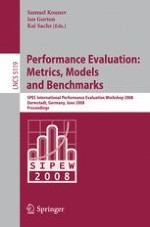2008 | Buch
Performance Evaluation: Metrics, Models and Benchmarks
SPEC International Performance Evaluation Workshop, SIPEW 2008, Darmstadt, Germany, June 27-28, 2008. Proceedings
herausgegeben von: Samuel Kounev, Ian Gorton, Kai Sachs
Verlag: Springer Berlin Heidelberg
Buchreihe : Lecture Notes in Computer Science
